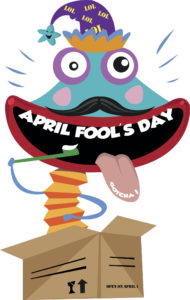
If you’re getting ready to make a big announcement, you probably want to avoid making it on April 1. Here in the United States, many of the big news stories made on April Fools’ Day are hoaxes, causing confusion while people take things seriously. This is why many people consider the day to be creepy and manipulative. Some even think it can be nasty and deceitful.
On the other hand, most people consider April Fools’ Day to be fun and playful. In fact, it can be good for your health, because it encourages you to laugh, which reduces stress and strain on the heart. It can be great for kids and adults, except when it’s taken too far.
Celebrating April Fools’ Day
It’s thought that April Fools’ Day began in Europe. Certainly, the oldest references to the day are from the Middle Ages. The Roman festival, Hilaria, is thought to be a precursor to the holiday. Hilaria celebrates the March Equinox and the Anatolian mother goddess, Cybele. The day was reserved for rejoicing and celebrating, no sorrow or grief was allowed on the day. But it is a long way from what we know as prank central.
Chaucer’s “Canterbury Tales” talks about a vain cock, a rooster, who is tricked by a fox on what is thought to be April 1. About 200 years later, a Flemish poet told a tale of a nobleman who would send his servants on foolish holidays on April 1. This legend lives on in Ireland. A prankster sends a victim with an important letter that reads, “send the fool to someone else.”
During the Middle Ages, New Year’s Day was celebrated on March 25. It turned into a weeklong holiday, ending on April 1. Those who still celebrated New Year’s Day on January 1 made fun of those who celebrated in March.
A French poet referred to April 1 as poisson d’avril, which means Fish of April, and today in France, people attempt to attach paper fish to the back of a victim without being caught. Typically, the newspapers print one false story on April 1, usually with a reference to a fish as a clue that it might not be true.
Pranks That Failed
In 1998, two radio hosts announced that the Boston mayor was dead. It was a prank that went on over the full course of a show. However, when the mayor got off a plane and realized that he was supposed to be dead, he asked the Federal Communications Commission to fine the radio station. The station attempted to apologize, but the hosts were fired.
In another April Fools’ prank from Boston, it was announced on air that the Great Blue Hill in Massachusetts had become volcanic. At the end of the footage, a card read “April Fool,” but the public went crazy calling law enforcement to find out if they should evacuate.
In 1999, at the height of the dot-com boom, pranksters started selling “nodes” for $100. On April 1, they revealed it as a hoax, but they ended up being sued and having the FBI investigate their company. This April Fools’ prank ended up being costly, in a sense, and potentially illegal.
Most people probably remember last year’s big failure when Google tried to install a “mic drop” button in emails. This April Fools’ prank upset millions of customers who use Google email professionally. It caused “more headaches than laughs,” and Google had to turn off the feature. Wonder how they can top that? We’ll have to see.
If you’re participating in April Fools’ Day pranks, make sure you aren’t harming anyone. It should be a day of fun and playfulness, giving people a chance to laugh and enjoy life.

